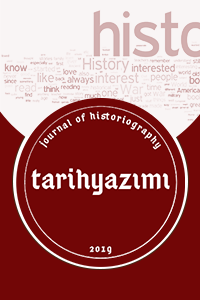Mütefennin Zabit Olarak On Dokuzuncu Yüzyıl Asker Ressamları: Harbiye Mezunlarının Resimdeki Realist Tavrının Kökenleri Üzerine
Bu çalışmanın amacı, 1834’te açılan Harbiye Mektebi’nden mezun olan asker ressamların eğitimsel ve entelektüel arka planlarının resme yönelik yaklaşımlarını nasıl şekillendirdiğini incelemektir. On dokuzuncu yüzyılın zengin görsel kültürü içinde çok büyük oranda manzara ve natürmort resmeden ve sanat tarihi kapsamında ağırlıklı olarak bu yönleriyle ele alınan asker ressamlar grubunun, tercihlerinde etkili olan unsurları sorgulayarak resim derslerinin rolünü, beslendiği kaynakları ve Harbiye’nin resme bakışını açıklamaya çalışıyorum. 1845’ten 1877’ye kadar ele aldığım ders programlarından modern resimle alakalı olan dersleri, Tanzimat sonrası ağır basan bilimsellik ve fonksiyonellik kapsamında değerlendiriyorum. Bu bağlamda çalışma, taraftan modern resmin ve realist tavrın Osmanlı Müslüman nüfusu içinde hangi dinamiklerle içselleştirildiğini açıklamaya girişirken, diğer taraftan modern resmin Harbiye’de sanatsal bir etkinlikten ziyade modernleşme politikası içinde bir araç olarak görüldüğünü yeniden vurgulama gayretindedir.
Anahtar Kelimeler:
Harbiye, asker ressamlar, realizm, manzara, natürmort, fonksiyonellik, bilgi üretimi
Nineteenth-Century Military Painters as Mütefennin Zabits: On the Origins of Harbiye-Graduates’ Realist Attitude in Painting
This study aims to examine how military painters' educational and intellectual backgrounds who graduated from Mekteb-i Harbiye (the Imperial Military Academy, 1834) shaped their approach to painting. I am trying to explain the role of painting lessons, the sources they fed on, and Harbiye's view of the painting by questioning the factors that are effective in the preferences of the military painters, who mostly painted landscapes and still-lifes in the rich visual culture of the nineteenth century. I evaluate the specific courses related to modern painting from the curricula between 1845 to 1877 within the scope of science and functionality that prevailed after the Tanzimat (Reorganization) period (1839-1876). In this context, the study attempts to explain the dynamics in which the Ottoman Muslim population internalized modern painting and the realist attitude; on the other hand, it emphasizes that modern painting is seen as a tool in the modernization policy rather than an artistic activity at Harbiye.
Keywords:
Harbiye, military painters, realism, landscape, still life, functionality, knowledge production,
___
- Adıvar, A. (1939). La Science chez les Turcs Ottomans. Paris: G. P. Maisonneuve.
- Arşiv Belgelerine Göre Osmanlı Eğitiminde Modernleşme. (2014). İstanbul: Başbakanlık Devlet Arşivleri Genel Müdürlüğü.
- Asil, E. (2017). The Pursuit of The Modern Mind: Popularization of Science, The Development of The Middle Classes, And Religious Transformation In The Ottoman Empire, 1860-1880. (Unpublished Ph.D. Dissertation). The University of Chicago.
- Beydilli, K. (1995). Türk Bilim ve Matbaacılık Tarihinde Mühendishâne, Mühendishâne Matbaası ve Kütüphânesi (1776-1826). İstanbul: Eren.
- Bouquet, O. (2015). Is İt Time To Stop Speaking About Ottoman Modernization?. Order and Compromise: Government Practices in Turkey from the Late Ottoman Empire to the Early 21st Century. M. Aymes, B. Gourisse, É. Massicard (Eds). Leiden: Brill, 45-67.
- Burçak, B. (2005). Science, A Remedy for All Ills Healing “The Sick Man of Europe”: A Case for Ottoman Scientism. (Unpublished Ph.D. Dissertation). Princeton University, the Department of Near Eastern Studies.
- Çetinsaya, G. (2009). Kalemiye’den Mülkiye’ye Tanzimat Zihniyeti. Modern Türkiye’de Siyasi Düşünce: Cumhuriyet’e Devreden Düşünce Mirası Tanzimat ve Meşrutiyetin Birikimi. T. Bora, M. Gültekingil (Eds.) İstanbul: İletişim, 54-71.
- Derviş Paşa. (1865). Usul-i Hikmet-i Tabiiyye, İstanbul: Darü’t-tıbbatü’l-amire.
- El-hac Hafız İshak Efendi. (1832). Mecmua-i Ulum-ı Riyaziye. vol.3. İstanbul: Darü’t-tıbbatü’l-amire.
- Ergin, O. N. (1977). Türk Maarif Tarihi I-II. İstanbul: Eser.
- Ersoy, A. (2018). The Sultan and His Tribe: Documenting Ottoman Roots in the Abdülhamid II Photographic Albums. Ottoman Arcadia: The Hamidian Expedition to the Land of Tribal Roots (1886). B. Öztuncay, Ö. Ertem (Eds.) İstanbul: ANAMED, 31-63.
- Germaner, S. (2011) Osmanlı Manzara Resminde Mekan Yorumu. Mekanın Poetikası, Mekanın Politikası. Z. İnankur, R. Lewis, M. Roberts (Eds.) İstanbul: Pera Müzesi, 235-243.
- Günergun, F. (2005) Mekteb-i Harbiye’de Okutulan Mimarlık ve İnşaat Bilgisi Dersleri İçin 1870’li Yıllarda Yazılmış Üç Kitap. Afife Batur’a Armağan: Mimarlık ve Sanat Tarihi Yazıları. D. Mazlum, A. Ağar, G. Cephanecigil (Eds.) İstanbul: Literatür, 151,163.
- Gölönü, B. (2018). Images with A Second Life: Photographs of the Hüdavendigar Province that Became Landscape Paintings. Ottoman Arcadia: The Hamidian Expedition to the Land of Tribal Roots (1886). B. Öztuncay, Ö. Ertem (Eds.) İstanbul: ANAMED, 107-121.
- Istılahat-ı İlmiye Encümeni. (1914). Sanayi-i Nefise Istılahatı, Celal Esad (Ed.) İstanbul: Matbaa-i Amire.
- İbnülemin Mahmud Esad. (1891). Tarih-i Sanayi. İzmir.
- İhsanoğlu, E. (1989). Başhoca İshak Efendi: Türkiye’de Modern Bilimlerin Öncüsü. Ankara: Kültür Bakanlığı.
- (2004). Ottoman Science: The Last Episode in Islamic Scientific Tradition and the Beginning of European Scientific Tradition. Science, Technology and Learning in the Ottoman Empire: Western influence, Local institutions, and the Transfer of Knowledge. Hampshire: Ashgate, 11-48.
- İnay Erten, Ö. (2018). Çok Yönlü Bir Kişilik: Ressam Hüseyin Zekai Paşa. (Unpublished Ph.D. Dissertation). Mimar Sinan Güzel Sanatlar Üniversitesi.
- İshak Efendi. Kavaid-i Ressamiye. İstanbul, n.d.
- Martykánová, D. (2020). Science and Technology in the Ottoman Language of Power (1790s-1910s). European Journal of Turkish Studies, (31), 1-19.
- Mehmet Esad. (1894). Mirat-ı Mekteb-i Harbiye. İstanbul: Şirket-i Mürettibiyye.
- Miralay Osman Nuri. (1874). Usul-i Cedide-i Hendese. Mekteb-i Harbiye-i Şahane.
- Mösyö Leclercq. (1875). Fenn-i Mimari. M. Rifat (Tran.) Mekteb-i Fünun-ı Harbiye-i Hazret-i Şahane.
- Namık Kemal. (1889). Mukaddime-i Celal. Kostantiniyye: Ebu’z-Ziya.
- Ölmez, A. (2017). Modern Osmanlı Ordusunda Alaylılar ve Mektepliler. İstanbul: İz.
- Ressam Mirliva Osman Nuri. (1895). Fenn-i Menazır ve Sulu Boya Tarifatı. Dersaadet: Osmaniyye.
- Şehabeddin. (1921). Türk Muasır Ressamlarından Üstad A. Rıza Bey. Servet-i Fünun, (1469), 147-148.
- Şerifoğlu, Ö. F. (ed.) (2018). İstanbul’un Ressam Hoca Ali Rıza: Ev ve Şehir. vol. 1. İstanbul: Emlak.
- Yalçınkaya, A. (2015). Learned Patriots: Debating Science, State, and Society in the Nineteenth-Century Ottoman Empire. London: The University of Chicago.
- Yıldız, M. (2012). Tanzimat Fermanı: Genel Değerlendirme; Karşılaştırmalı İlmî Metin,” Journal of Islamic Research 5, (1), 126-177.
- Yinilmez Akgün, Seval. (2013). The First Physics Textbook in Ottoman State: Usûl-ü Hikmet-i Tabiiye (Introduction to the Philosophy of Nature) Turkish History Education Journal 2, (2), 58-77.
- Yayın Aralığı: Yılda 2 Sayı
- Başlangıç: 2019
- Yayıncı: Ahmet ŞİMŞEK
